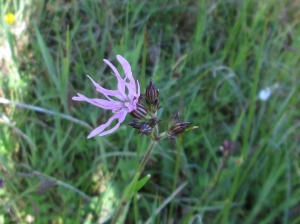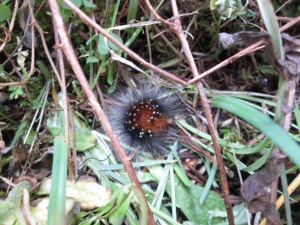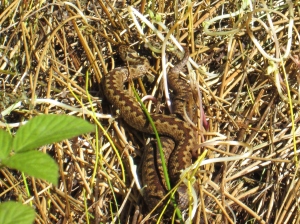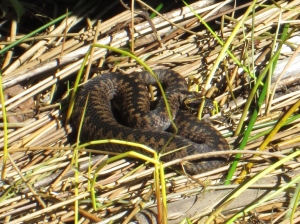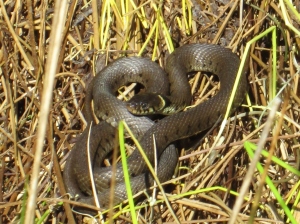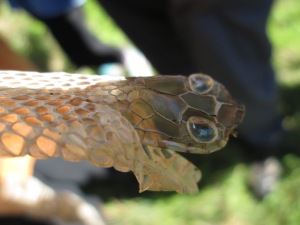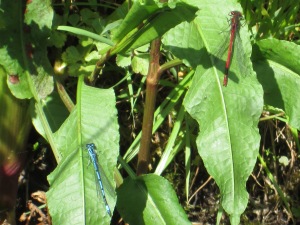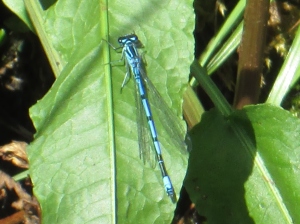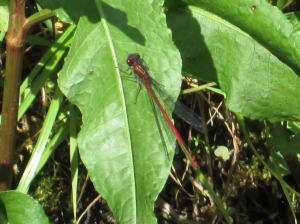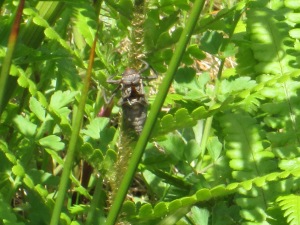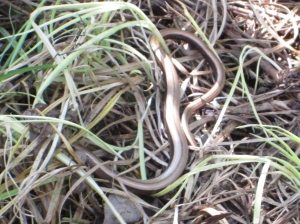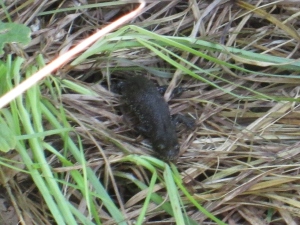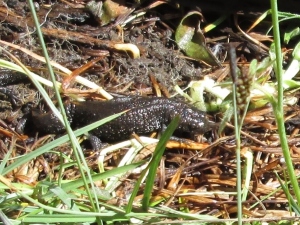Iolo Williams spent his 'Perfect Day' at Parc Slip, see the video below.
Welcome to the blog of Parc Slip Nature Reserve, owned and managed by the Wildlife Trust of South and West Wales. More information can be found on our website here www.welshwildlife.org Follow us on Facebook https://www.facebook.com/ParcSlipNatureReserve or Twitter https://twitter.com/ParcSlipNR. Sign up to our E-Newsletter here http://bit.ly/1oQd44k
Saturday 8 November 2014
Monday 3 November 2014
Patchwork Challenge Update for the end of Summer- Paul Parsons
September and October are usually good for migrants, with a fair chance of
finding something unusual. However, September was so mild and sunny that very
little bird passage was noted on the reserve.
Highlights
were a Tree pipit and three Sand martins on the 2nd, a Chiffchaff and a small influx of
Robins and Thrushes on the 3rd and Willow warbler and Sedge warbler on the 5th. 6 Teal were new in on the 7th and a Common snipe was seen.
A new species for the list was Yellow wagtail- three were spotted on the new scrapes on the 9th. On the 17th, flocks of Swallows and House martins were seen heading south, Blackcap and Sedge warbler were sighted, Teal numbers were up to 18 and 20 Meadow pipits were in the fields.
On the 22nd a juvenile Water rail was on the Visitor Centre pond. A female Wigeon on the Northern Wetlands on October 10th was my 90th bird of the year and on the 11th
7 Goosander flew over the café and the first Redwings of the winter were seen.
The rest of the month was quiet but a Hobby was reported on the 17th on the Northern Wetlands.
Paul Parsons
NB. Paul is currently taking part in the Patchwork Challenge, where birders go out in their local area to spot as many birds as they can. He has chosen Parc Slip Nature Reserve as his patch. Read more about Paul's progress in the older posts on this blog.
 |
| Moorhen and chick. Paul Parsons. |
A new species for the list was Yellow wagtail- three were spotted on the new scrapes on the 9th. On the 17th, flocks of Swallows and House martins were seen heading south, Blackcap and Sedge warbler were sighted, Teal numbers were up to 18 and 20 Meadow pipits were in the fields.
 |
| Water Rail. Paul Parsons |
 |
| Female Wigeon. Paul Parsons |
The rest of the month was quiet but a Hobby was reported on the 17th on the Northern Wetlands.
Paul Parsons
NB. Paul is currently taking part in the Patchwork Challenge, where birders go out in their local area to spot as many birds as they can. He has chosen Parc Slip Nature Reserve as his patch. Read more about Paul's progress in the older posts on this blog.
Thursday 9 October 2014
Parc Slip Lapwing Revival Project

The Lapwing is an iconic farmland bird which has undergone drastic declines in populations as a result of loss of breeding habitat. Today the lapwing is a U.K. and Wales priority species requiring urgent positive action.
Over the next few months, we will be working hard to reverse the decline at Parc Slip Nature Reserve, through a series of habitat creation and management projects. These will include the creation of wetland scrapes and cryptic nesting sites to the appropriate management of wetlands, meadows and arable fields. In addition to the practical habitat management and creation, the project will also undertake research and monitoring on the reserve and in the wider landscape to better understand and conserve the species in Bridgend.

One of the objectives of the project is to remove scrub from breeding grounds. Lapwings nest away from scrub as it harbours predators. Therefore the removal of scrub in key breeding sites increases the overall suitability of the nesting ground. Over the past 10-15 years the main breeding grounds and other outlier sites at Parc Slip have become encroached with scrub and immature woodland and we need your help to remove it!
We are looking for Lapwing Champions to help us with this project. By helping the Wildlife Trust with this project, you will gain:
•Practical experience of habitat management, including scrub clearance and scrape creation.
•Official certificates presented to Lapwing Champions who complete more than five work parties.
•Enjoyable days working with like minded people to help conserve the lapwing.


If you would like to help us with this project, send Rose an email or ring 01656 724100 to register as a volunteer or come along to our next Lapwing Conservation Day on Friday 10th October 2014 at 10:30am.
Wednesday 3 September 2014
Patchwork Challenge Update, a Guest Blog from Paul Parsons
May at Parc slip was quiet on the passage bird front. I spent the
middle two weeks on a birding trip to China and as far as I know, I only missed
out on a Common sandpiper which was found on the wader scrapes.
 |
| Chiffchaff, Paul Parsons |
During May and June I saw nothing new for the list but it was good to see 2
pairs of Little ringed plover successfully breeding on the new scrapes, with newly hatched
chicks seen on 6th June.
July started quiet too with nothing new until the
months end when a Greenshank and Green sandpiper were reported from the scrapes, I did
manage to see the Sandpiper the next day but the Greenshank had moved on. Also
a pair of Tufted duck had 8 ducklings on the Northern wetlands.
 |
| Redstart, Paul Parsons |
August was better,
with some autumn migration evident towards the months end. I saw my first
Collared dove of the year on 3rd and Grey wagtail and Redstart were added to the list on
14th. 2 Tree pipit and a Lesser whitethroat were new in the Willows at the
end of the canal on 19th and a Common snipe dropped onto the wader scrapes on 21st.
 |
| Lesser whitethroat, Paul Parsons |
Finally
3 Spotted flycatchers were new on 31st, taking my total to 88 for the
year. Migration will be in full swing for the next 6 weeks and hopefully something good will turn
up after the forecasted easterly winds this week.
 |
| Spotted Flycatcher, Paul Parsons |
Friday 27 June 2014
Small Blue Butterflies make a Comeback at Parc Slip
The small blue butterfly (Cupido minimus) is the UK’s smallest butterfly, with a wingspan of
only 16-27mm. It’s a beautiful little butterfly, recognised by the dark blue on
the upper surface of its wings and dark spots on the silver-blue underwing. It
flies from mid-May to August and lays its eggs on the caterpillar food plant,
kidney vetch. As is the story with much of our UK wildlife, unfortunately the
small blue has experienced a decline in both population and distribution over
the whole of the UK.
 |
| Small Blue Female by Long Pond June 2014 |
This decline has been noticed locally, with the number of
adults seen at Parc Slip Nature Reserve outside Bridgend in South Wales slowly
reducing over the years. In 2012, the Wildlife Trust of South and West Wales
enlisted the help of local Bridgend school children to improve the habitat for
small blue on Parc Slip to see if we could boost populations on the reserve
again.
 |
| Jacob planting seeds |
Kidney vetch seeds and planting kits were sent out to two
local primary schools, Oldcastle and St Roberts, where the children planted the
seeds and grew them in their classrooms. Once the seedlings began to emerge, the
plants were brought to Parc Slip and planted out on the reserve. The large majority were planted on the banks of the new pond near the Northern Wetlands hide and they have been a huge success, growing very tall indeed.
 |
| Kidney Vetch at Long Pond |
Now we have some very good news to report! The kidney vetch
has been growing steadily over the last two years and this year has produced a
wonderful display of flowers. On Friday 20th June, staff from the
Wildlife Trust were thrilled to find a female butterfly near the kidney vetch.
Since then, numerous larvae have been found feeding on the kidney vetch and there
have been a number of reports of small blue on the nature reserve by visitors.
 |
| Small Blue Larvae on Kidney Vetch June 2014 |
Thank you very much to the local school children for
planting and growing the seeds in their classroom, and to Biffa for funding the
project.
Wednesday 28 May 2014
A Reptile Ramble at Parc Slip; A Guest Blog by Karen Coles
I was lucky enough to go on my second ever Reptile Ramble last Wednesday, at Parc Slip nature reserve. Some of the pictures are a bit blurry, sorry. It was impossible to see whether they were in focus at the time, due to the strong sunlight (nothing to do with my woeful photography skills – cough, cough).
Lady’s Smock, Ox-eye daisies, Cowslips and beautiful Ragged Robin were just some of the gorgeous wild flowers we saw.
Spotted this Drinker moth caterpillar:
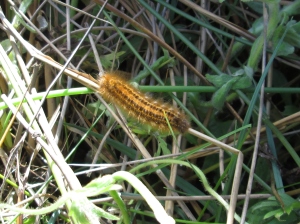 Plus this beauty, which I’ve been reliably informed (by twitter) is a Garden Tiger moth caterpillar! Glad I didn’t pick it up!
Plus this beauty, which I’ve been reliably informed (by twitter) is a Garden Tiger moth caterpillar! Glad I didn’t pick it up!
Dingy Skippers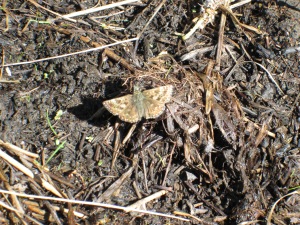 Common Blues
Common Blues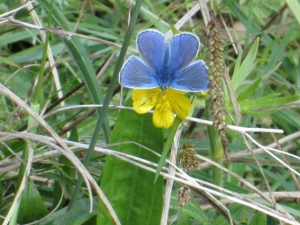 and Green-veined White butterflies were everywhere. Also saw a Small Copper, and Rose (the walk leader) pointed out some Orange Tip eggs on the underside of Lady’s smock.
and Green-veined White butterflies were everywhere. Also saw a Small Copper, and Rose (the walk leader) pointed out some Orange Tip eggs on the underside of Lady’s smock.
 Common Blues
Common Blues and Green-veined White butterflies were everywhere. Also saw a Small Copper, and Rose (the walk leader) pointed out some Orange Tip eggs on the underside of Lady’s smock.
and Green-veined White butterflies were everywhere. Also saw a Small Copper, and Rose (the walk leader) pointed out some Orange Tip eggs on the underside of Lady’s smock.
We also saw grass snakes, one of which stayed still long enough for a photograph.
This is the shed skin of a grass snake, showing the eye scales. To find the whole skin intact is apparently quite rare, so we were extremely lucky to see it. What a fabulous face. Wish I could have kept it!
The highlight of the day for me was watching the courtship of two palmate newts in the pond. The male would swish his tale every now and then, and then shake it to waft pheromones to his beloved. She didn’t look too impressed, and we left without knowing if it ended happily ever after (hope so!). Sadly, I couldn’t get a photo of the newts, but did get these damselflies. I’ve been told they’re an azure blue and a large red.
Someone did spot a dragonfly, but I missed it :-( We did, however, spot this dragonfly exuvia (shed skin) on an emergent plant. Sorry the photo isn’t great. Just love these things and again, wish I could have taken it home. Not sure my hubby would be too happy if I did though.
This female slow worm was so well-camouflaged that we almost missed it.
Last and rarest creatures we saw were some Great Crested Newts. Feel honoured to have seen them.
To top off a wonderful morning, two ravens flew overhead, and just made my day!
Thanks again to Rose, and to all at Parc Slip nature reserve.
Karen Coles (http://kecoles.wordpress.com/)
If you would like to join us on one of our weekly Reptile Rambles, please book with Rose Revera on r.revera@welshwildlife.org or 01656 724100. Visit the website to see available dates and more information.
Thursday 8 May 2014
Dog Walking at Parc Slip
We love to use this blog to share with you updates on the
nature reserve, your photos and facts about the wildlife. Unfortunately,
sometimes we have to let you know about some of the less pleasant aspects of
managing the nature reserve! Apologies in advance for some of the photos in
this blog entry…
One of the main issues we have on the nature reserve, as
some of you may know, is the amount of dog mess that is left on the paths here.
The good news is that despite the increase in visitors to Parc Slip over the
last year, the amount of mess left on the paths has actually decreased since
the reopening of the centre. Most of the dog walkers that visit Parc Slip are
very responsible and carry poo bags with them- thank you very much to these
owners. However, there is still enough mess left on the paths to cause
problems.
 |
| Dog mess left on the path leading out of the picnic area |
As well as being unsightly and a potential disease risk for
the people using the nature reserve (imagine how unpleasant it is for reserve workers strimming the paths, or for school groups visiting the nature reserve), there are also implications for the
wildlife. Dog mess can actually increase the nutrients in the soil, which
allows the more competitive species such as nettles and grasses to grow, which
leads to a reduction in wildflowers along the paths. We also unfortunately
occasionally get poo bags thrown into the hedgerows, where they hang in the
trees and are very unsightly and unpleasant. The bags (even the biodegradable
ones) will not rot down for a long time and can cause a hazard to wildlife that
could eat them.
 |
| Nettles can overtake wildflowers on the paths where dog mess is left |
So here are our plans to help reduce the problems of dog
mess at Parc Slip. Hardy Wildlife Trust staff and volunteers are undertaking
weekly ‘Poo Patrols’ around the main paths at Parc Slip. Quick removal of the
mess from the paths will prevent the problems outlined above and create a much
more pleasant environment for people and wildlife at Parc Slip. However, this does use up valuable staff time that would otherwise be spent on conservation work. Please help us reduce the time spent on Poo Patrol by picking up after your dog.
 |
| Wildlife Trust staff tackle this unpleasant job |
Bins have been placed on the nature reserve in prominent
places; at the car park, the end of the canal path, by the willow weaved tree and at
the top of the Nant-y-Gedd cascades. If you have forgotten your poo bags, you
can pick them up for free from the Visitor Centre. We are also currently in the
process of fundraising for a dog poo bag dispenser that will be fitted in the
car park to make it as easy as possible for dog owners to pick up after their
dog.
Lastly, we are looking for artistic children to help get the
messages across! We’d love to get some posters put up on the nature reserve
that encourage people to pick up after their dogs, so if your children would
like to get their pens and pencils out to help the wildlife at Parc Slip, please
send the posters through to Rose Revera, WTSWW, The Nature Centre, Fountain
Road, Tondu CF32 0EH
Thank you for picking up after your dog and helping keep
Parc Slip a safe and pleasant place for wildlife and people.
Thursday 1 May 2014
Patchwork Challenge April; A guest blog from Paul Parsons
April is the busiest month for returning migrants which have spent
the winter in Southern Europe and Africa. I saw my first Willow warbler on the 3rd and a Canada goose was
sitting on a nest on the island of the North wetland.
 |
| Willow Warbler |
A second winter Glaucous gull that has been frequenting nearby
Mynydd Baeden since February was seen flying north over the reserve on the 8th, the highlight of the month for me. On
the 10th a pair of Greylag geese flew low over the wader scrapes and a female
Stonechat was in the south western fields. A female Goosander flew east along
the railway track on the 12th and my first Whitethroat was singing away on the
14th.
 |
| Greylag geese |
 |
| Whitethroat |
A Rook was unexpected, flying south over the monument on the 17th and 2 House martins and a Swift were feeding over the
wader scrapes on the 21st. On the 22nd I finally caught up with the two
Wheatear that had been seen on the scrapes and there were 3 singing Reed
warblers new in on the same day.
 |
| House martin |
 |
| Tufted duck being chased by coot! |
 |
| Reed warbler |
Friday 4 April 2014
Patchwork Challenge Update; A Guest Blog from Paul Parsons
March 20th was cloudy with a brisk Southerly wind, birds seemed on
the move with a Cormorant and 50+ herring gulls passing over the reserve. A pair of Lesser black back gulls
were on the Northern wetland and 4 singing Chiffchaff were noted.
On 24th the wind had turned South Easterly, Sparrowhawk and
a pair of Jay were seen and new birds for the year were Linnet and a singing Blackcap.
 |
| Jay, M.J. Clark |
At dawn on the 25th there were 7
Sand martin feeding over the Northern wetland and birds were very active in the morning sun. The Canada geese were honking and
fighting, Lapwings, Meadow pipits and Skylarks were displaying and the Robins and Thrushes were singing. Another 2
Sand martin flew past the new hide and a Stock dove also flew through.
 |
| Northern Wetlands in the sun, including Highland cow Hamish! Paul Parsons |
An afternoon visit on the 29th was quiet until I was
walking back from the new hide and the sun came out from the cloud. A cracking
Osprey flew right over my head and over the Lapwing field but the tall hedge
prevented me getting a photo. A male Swallow was over the field when I got further along, taking
my bird list to 65.
The 30th was sunny and warm, 2 more Blackcaps were
back and singing and a Goshawk circled high above the reserve. Butterflies were
much in evidence with Brimstone, Peacock, Small tortoiseshell and Comma all on
the wing.
 |
| Blackcap, Amy Lewis |
Hopefully the good weather will continue into April. The first Willow warblers
should be arriving any day now (NB. the first willow warblers were heard singing on 31st March by reserve wardens, RR), to be followed by Sedge warbler, Reed warbler and Whitethroats.
Tuesday 1 April 2014
Parc Slip Nature Reserve, Fountain Road, Gondwanaland; A guest blog from Rudi Bright
Hi, my name
is Rudi (Blog), I am 10 years old and I am a member of the ‘Friends of Parc Slip’
conservation group. Once a month we help out doing some work around the
reserve. On Saturday 22nd March we were sowing wildflower seed mix on the bare earth bunds
at the new scrapes. It was very muddy and I nearly lost my new wellies a couple
of times.
 |
| Rudi stuck in the mud! |
One of the
times I got stuck in the mud I looked down and saw a stone with funny markings
on it, I knew it was a fossil but wasn't sure what type so I took it home to
identify.
It turned
out to be a Lepidodendron, a part of the stem of a lycopod which is a giant
clubmoss that grew to over 30m high (that’s even higher than the new elevatedhide!). The diamond shaped marks on the fossil are leaf scars. As one of
the tallest trees it would have formed the tree canopy.
But what
was this doing at Parc Slip?
Well, this
plant was around a long long time ago during a period of time known as the
Upper Carboniferous age. These plants and others like them are responsible for
the great accumulations of coal that Wales is well known for. But way back then
the land at Parc Slip was not in Wales as we know it but was part of a giant
landmass known as Gondwanaland which was covered with forests and swamps.
 |
| Rudi with the fossil |
As the life
in these forests and swamps died the sea washed sediment over it and the
material was compressed to form peat. This happened over and over again and
built up different layers of sediment which are known as cyclothems. As the
weight of the material above built up the pressure eventually turned the peat
into coal.
So next
time you are wondering around Parc Slip just remember, the signs of nature are
really all around you, even buried deep in the ground.
Wednesday 26 March 2014
Seed Scattering on the new wetland with Friends of Parc Slip
The meeting of the Friends of Parc Slip on Saturday 22nd March involved some large scale gardening! The new wetland at Parc Slip is looking fresh and raw following its excavation, so we were out scattering seeds to help the wild flowers to move in.
The wildflower mix includes some grasses, such as yorkshire fog and wildflowers such as bedstraws, which are sourced from an environmentally friendly company that grows its seed crops in England. Additionally, we were adding kidney vetch seeds to the south facing slope of the bunds, a plant which is fantastic for butterflies, particularly the small blue which has been scarce on the reserve for the last few years.
The work was very muddy and a few people got very close to losing their wellies (see photo below!), but we had a great morning! Anyone is welcome to join us for the Friends of Parc Slip monthly meetings- give Rose an email or ring 01656 724100 to be added to the mailing list.
If you would like to donate towards the new elevated bird hide, you can download a donation form from this page and return it to
 |
| The Friends of Parc Slip gang |
We were concentrating on seeding the large bunds which surround the wetland- these were formed from the material that was removed when digging the scrapes and will serve to screen the wetland from people walking to the hide to avoid startling the wild residents.
 |
| Working on one of the bunds |
 |
| Margaret planting kidney vetch seeds |
 |
| Small blue butterflies, MJ Clark |
The work was very muddy and a few people got very close to losing their wellies (see photo below!), but we had a great morning! Anyone is welcome to join us for the Friends of Parc Slip monthly meetings- give Rose an email or ring 01656 724100 to be added to the mailing list.
 |
| Rudi stuck in the mud! |
Parc Slip Elevated Bird Hide Fund, Freepost RRJG-XCUZ ZUHU, The Wildlife Trust of South and West Wales, Nature Centre, Fountain Road, Tondu, Bridgend CF32 0EH or ring alternatively, give us a ring in the office on 01656 724100.
Subscribe to:
Posts (Atom)
